Sol Summary – May 8th
Crew 261 Sol Summary Report 08-05-2023
Sol 8
Summary Title: Gypsum crystals on the Martian soil
Author’s name: Aline Decadi, XO
Mission Status: nominal
Sol Activity Summary: Today took place 2 EVAs:
– EVA-11 with the following 4 crew members: James Burk (Commander) (EVA Lead), Julien Villa-Massone (Crew Engineer), Cecile Renaud (GreenHab Officer), Kris Davidson (Journalist) (Not In Sim – Not Wearing Suit)
– EVA-12 with the following 4 crew members: Audrey Derobertmasure (HSO), Erin Kennedy (Crew Roboticist), Aline Decadi (XO) (EVA Lead), Kris Davidson (Journalist) (Not In Sim – Not Wearing Suit)
EVA-11 conducted testing of ADAPA 360 Drone. The crew walk outside of Hab to a suitable flat piece of ground for drone launch & landing. This preliminary testing of the drone was successfully, and the EVA was also successful. Another EVA is foreseen to take 3D imaging to map a terrain on the field.
EVA-12 had the following purpose:
1) Find, investigate, and collect Gypsum crystals on the Glistening Seas region from selenite, the transparent form of gypsum. This relates to Atmosphinder experiment as it could be an analogous feature to CO2 gas jet expulsions in the Mars South Polar region.
2) Atmosphinder electronics environmental sensor data logging.
EVA-12 ventured North of the Hab to the vicinity of the Valles Marineris region, located East of Cow Dung Road, and South of Brahe Highway.
Upon approaching the destination, it became evident why this location is nicknamed “Glistening Seas”. Gazing across the horizon, sparkles could be seen from the sunlight reflecting on the crystals. Gypsum crystals protruded from the red-tinged dirt below. The EVA crew investigated a cluster of these and collected samples. The EVA crew investigated this area thoroughly, finding rocks of interest and additional crystals. The crew was elated with the plethora of crystals and fascinating geological features!
Atmosphinder was extracted from the rover for a test. The wind gusts were powerful in this region as it was a clear plain. Atmosphinder was given an initial push, and it traveled ~70 m as propelled by the wind. Additional testing occurred, with the same results. The result was compelling to observe a structure moving on its own, venturing to explore the vastness of Mars! After a test concluded in disassembly, the area was thoroughly checked for remaining pieces, and the pieces were brought back to the rover.
Crew health checks were completed regularly by the EVA lead, everyone was feeling great and in great spirits. We received coordinates to a point of interest of a crew member’s lost drone. We conducted a search for the lost drone, akin to a ‘geocaching’ activity. The search concluded without retrieving the drone, though admittedly, admiring the incredible geology at that point of interest.
The EVA-12 resulted in awe-inspiring observations and making connections of those observations to Mars. New information was learned about Atmosphinder robot that would only be possible in this unique environment. There was an experiential confidence boost for some of the EVA crew. The collected crystal samples will be further investigated through a microscope, shared, and whimsically gazed upon. Many thanks to the entire crew — both on the EVA, at HabCom, and behind the scenes!
The crew spent the rest of the day: Audrey Derobertmasure (HSO) performed a demonstration on her thesis on Cardiovascular measurements and the rigorous protocol under development for handling and storing human biological samples (as part of the COSMOS experiment); having dinner together and preparing the next day’s experiments and EVAs.
Look Ahead Plan: we will conduct 2 EVAs tomorrow: EVA-13 in the morning for the rescue of Julien’s drone, and fly ADAPA drone to get footage; EVA-14 in the evening for photoshoot in the immediate vicinity of the Hab, according to mission request approval.
Anomalies in work: None.
Weather: Pleasant and sunny. Very windy in the afternoon.
Crew Physical Status: Nominal.
EVA: EVA-11 in the vicinity of the Hab; EVA-12 on the North of Cow Dung Road.
Reports to be filed: HSO Report, EVA Report, Operations Report, Journalist Report, Pictures of the day, GreenHab Report.
Support Requested: None.
Operations Report – May 8th
Crew 261 Operations Report 08-05-2023
SOL: 8
Name of person filing report: Julien Villa-Massone
Non-nominal systems:
· Remote observatory
· 1 Helmet, 1 headset
Notes on non-nominal systems: Failed helmet and headset are set aside and labeled as such
ROVERS
Spirit rover used: No
Hours: (before EVA) 220.8
Beginning charge: (Before EVA) 100
Ending charge: (On return from EVA, before recharging) N/A
Currently charging: Yes
Opportunity rover used: Yes
Hours: 124.5
Beginning charge: 100
Ending charge: 90
Currently charging: No
Curiosity rover used: Yes
Hours: 235.3
Beginning charge: 100
Ending charge: 77
Currently charging: No
Perseverance rover used: No
Hours: 263.1
Beginning charge: 100
Ending charge: N/A
Currently charging: Yes
General notes on rovers: Drove to intersection between Cow Dung Road and Brahe Hwy (north of base). Nominal operation
Summary of Hab operations: Nominal day
WATER USE: rate of 40 gallons / sol today. Trend since mission start of 33 gal/day means we will run out of water 2 days prior to mission end. This means, if we continue with this trend, the tank will be at 54 gallons when the mission ends (that’s 63 gallons short).
In the past 2 days, we consumed more water than normal. Unclogging the sink contributed to this increased water usage.
Water (static tank): 255 gallons remaining
Static tank pipe heater (on or off): off
Static tank heater (On or off): off
Toilet tank emptied: no
Summary of internet: Nominal
Summary of suits and radios: Nominal
Summary of GreenHab operations: Nominal.
WATER USE: 14 gals total
Heater: Off
Supplemental light: Off
Harvest: None
Summary of ScienceDome operations: Nominal.
Dual split: Off
POWER report: MPPT 1 and 2 are not providing any power. Meanwhile, MPPT 3 has been providing ~4kW when under suitable sunlight. Mission Support reset MPPT 1 and 2 in an attempt to fix this issue. MPPT 1 and 2 still do not provide any power.
Summary of RAM operations: Nominal
Summary of Tunnels maintenance: No zip-ties added.
Summary of any observatory issues: Nothing to report
Summary of health and safety issues: Nominal.
Questions, concerns and requests to Mission Support: Thank you for your support today.
Journalist Report – May 8th
Crew 261 Journalist Report 07-05-2023
Author: Kris Davidson, Crew Journalist
Since the beginning of recorded human history, we have long sought a way to make sense of the chaos of existence, to find the threads that bind us to the world and each other. Magic, religion, and science are three knowledge systems that we have turned towards across time to comprehend and control the great unknowns that have haunted us since the dawn of time.
Magic, religion, and science serve as mankind’s distinct approaches to understanding the universe and its mysteries. Magic, a primordial attempt to harness the elements, is rooted in folklore and myth, allowing us to channel our imperfect agency to shape the world to our desires. Religion, a collective endeavor, weaves stories and rituals to offer solace and structure while addressing questions that have plagued humanity since we first looked skyward. Science, born from our curiosity, is an ever-evolving quest for knowledge, methodically studying the universe and illuminating the dark crevices of ignorance through reason and empirical observation. Each of these knowledge systems represents our shared odyssey to decipher the cosmos and navigate the complexities of existence.
Science is commonly described as a march. We continue to gain more and more knowledge through science, and today it dominates in making sense of human existence and the cosmos. But even still, the wonder often associated with magic remains intact. On Sol 8, Transatlantic Mars Crew 261 has hit a good stride with the various experiments and projects, and as they progress so do feelings of wonder among the crew.
On EVA 12, led by Executive Officer Aline Decadi, with Erin Kennedy (Crew Robotics Engineer), Audrey Derobertmasure (HSO), and Kris Davidson (Journalist), the crew embarked on a quest to locate gypsum at the Glistening Seas region. This endeavor was related to the Atmosphinder experiment as the location has geological features similar to the Mars South Polar region. The crew was delighted not only by the spectacular landscape but the plentiful gypsum crystals sparkling in the area. During the EVA, Kennedy was also able to test the Atmosphinder on the kind of terrain it is being designed for.
Wonder frequently gives way to celebration. The entire crew celebrated with Greenhab Officer Cecile Renaud as the first tomato plant emerged after having been planted in Mars regolith stimulant (MMS-1 — Mojave Mars Stimulant, made by Martian Garden, developed by JPL for the 2007 Phoenix Lander mission). The small bud was first noticed late on Sol 7. On Sol 8, Renaud harvested a healthy batch of the spirulina growing in the photobioreactor, a promising result for the crew and future Mars colonists. Last but not least, EVA 11 on Sol 8, led by Commander Burk, was to test the Adapa 360 prototype, which could render high-resolution images of the MDRS for the Mars VR project — an endeavor that aspires to bring the magic and wonder of MDRS to others anywhere in the world.
As we continue to delve into the mysteries of the cosmos, the lines between magic, religion, and science may seem to blur, yet they remain distinct pathways to understanding. The triumphant march of science, the comforting embrace of religion, and the primal allure of magic, all serve as testament to our unending quest to make sense of existence. From the gleaming gypsum crystals of the Martian landscape to the first tomato plant sprouting in Mars regolith stimulant, the Transatlantic Mars Crew 261’s journey is a contribution to this larger quest. As we extend our reach to the stars, we carry with us the magic of wonder, the solace of belief, and the torch of scientific inquiry, ever illuminating the path ahead.
GreenHab Report – May 8th
Crew 261 GreenHab Report 08-05-2023
GreenHab Officer: Cécile Renaud
Environmental control: Door open from 6:45 to 19:00
Average temperatures: 59.0°F at 06:45, 90°F at 13:40, 77,9°F at 19:00
Hours of supplemental light: N/A
Daily water usage for crops: 6 gal at 07:15 + 6 gal at 19:00
Daily water usage for research and/or other purposes: 2 gal (including watering solution for biostimulant exp)
Water in Blue Tank 73 gallons
Time(s) of watering for crops: 07:15 and 19:00
Changes to crops: N/A
Narrative: N/A
Harvest: (include which crop and mass in grams) : None
Support/supplies needed: None
EVA Report – May 8th
Crew 261 EVA Report 08-05-2023
EVA # 11
Author: James Burk (Commander)
Purpose of EVA: Flight Testing of Adapa 360 Drone including general observations of design and performance.
Start time: 10:06 AM
End time: 10:55 PM
Narrative:
Overview of EVA
We flew the ADAPA 360 drone just outside of the Hab for the first time. We observed that it needs to have the stabilization engaged to be able to fly in general. The stabilization should be disengaged when launching, however.
After the first test, we walked farther towards the sign and flew it again for a longer range to capture better scenic video.
Issues Experienced During EVA 7
None
Outcomes
[Procedural] Announce times of over the radio so that EVALink team can match up with telemetry later.
Destination: Immediate vicinity of main Hab.
Coordinates (use UTM WGS 84): 518400 E, 4250900 N
Participants:
James Burk (Commander) (EVA Lead), Julien Villa-Massone (Crew Engineer), Kris Davidson (Journalist) (Not In Sim – Not Wearing Suit)
Road(s) and routes per MDRS Map: Walk outside of Hab to a suitable flat piece of ground for drone launch & landing.
Mode of travel: Walking
Vehicles you will be using (If applicable): N/A
Crew 261 EVA Report 05-06-2023
EVA # 12
Author: Erin Kennedy (Crew Roboticist), with inputs from Audrey Derobertmasure (HSO)
Purpose of EVA:
1) Find, investigate, and collect Gypsum crystals on the Glistening Seas region from selenite, the transparent form of gypsum. This relates to Atmosphinder experiment as it could be an analogous feature to CO2 gas jet expulsions in the Mars South Polar region
2) Atmosphinder electronics environmental sensor data logging
Start time: 1:05 PM
End time: 4:50 PM
Narrative:
Overview of EVA
EVA-12 ventured North of the Hab to the vicinity of the Valles Marineris region, located East of Cow Dung Road, and South of Brahe Highway. The objective was to find, investigate, and collect Gypsum crystals on the Glistening Seas region from selenite, the transparent form of gypsum. This relates to the Atmosphinder experiment as it could be an analogous feature to CO2 gas jet expulsions in the Mars South Polar region.
A briefing prior to the EVA ensured all EVA crew understood the plan. Atmosphinder in half-sized configuration (~1 m diameter) without the metal payload bay was included on the rover. The journey to the destination was done in parts to regularly check the status of the EVA crew. The rovers handled the terrain well, periodically needing 4 wheel drive on some of the inclines. The destination was reached without issue.
After walking on foot ~20 m off of the road, it became evident why this location is nicknamed “Glistening Seas”. Gazing across the horizon, sparkles could be seen from the sunlight reflecting on the crystals. Gypsum crystals protruded from the red-tinged dirt below. The EVA crew investigated a cluster of these and collected samples. The dirt surrounding the crystals was fine and a mixture of red and white coloured. The EVA crew investigated this area thoroughly, finding rocks of interest and additional crystals. The journey led to observing a cliff wall facing the crew. The crew was elated with the plethora of crystals and fascinating geological features!
A trek back to the rovers was made and Atmosphinder was extracted from the rover for a test. The wind gusts were powerful in this region as it was a clear plain. Two crew members stood downwind of Atmosphinder to be ready to intervene for a controlled stop. Atmosphinder was given an initial push, and it traveled ~70 m as propelled by the wind. Additional testing occurred, with the same results. The testing concluded after another hill test, with the halves of the hoops being severed. The result was compelling to observe a structure moving on its own, venturing to explore the vastness of Mars! The area was thoroughly checked for remaining pieces. The pieces were brought back to the rover.
The journey back commenced an hour before the close of the EVA window. Crew health checks were completed by the EVA lead, everyone was feeling great and in great spirits. We received coordinates to a point of interest of a crew member’s lost drone. We conducted a search for the lost drone, akin to a ‘geocaching’ activity. The search concluded without retrieving the drone, though admittedly, admiring the incredible geology at that point of interest. The journey back to the Hab commenced. The return to the Hab was completed. The Atmosphinder robot pieces, as well as the electronics which were data logging environmental sensor data for the EVA, was returned to the RAM.
The EVA-12 resulted in awe-inspiring observations, and making connections of those observations to Mars. New information was learned about Atmosphinder robot that would only be possible in this unique environment. The collected crystal samples will be further investigated through a microscope, shared, and whimsically gazed upon. Many thanks to the entire crew — both on the EVA, at HabCom, and behind the scenes!
Issues Experienced During EVA-12
1. [Technical] Radio range – Lack of comms due to no repeater
2. [Procedural] Julien flew his drone in high winds to follow the departing rovers and was forced to land it near Marble Ritual.
Outcomes
1) Collected samples of Gypsum crystals
2) Acquired visual imagery of analogous features to the south pole of Mars
3) Longest wind-propelled Atmosphinder roll
4) Atmosphinder electronics running environmental sensor data logging
5) Experiential confidence boost for some of the EVA crew members
Destination:
4254710 N, 518040 E
Coordinates (use UTM WGS 84): See above
EVA Participants: 4: Aline Decadi (XO) (EVA Leader), Audrey Derobertmasure (HSO), Erin Kennedy (Crew Roboticist), Kris Davidson (Journalist) (Not In Sim – Not Wearing Suit)
Road(s) and routes per MDRS Map:
Drive from Hab, Turn left, Go North on Cow Dung Road
Make a slight Left to continue North on Cow Dung Road towards Galileo Road intersection
Continue North on Cow Dung Road towards Brahe Highway intersection
If you have past Brahe Highway, you have gone too far
Park rover near (4254710 N, 517810 E)
Walk to destination (~0.3 km)
You have arrived at your destination!
Scout for crystals (~1.0 km, 0.75 hours)
Walk back to parked rover (~1.5 km)
Drive North to the intersection of Brahe Highway and Cow Dung Road
Make a 3 point U-turn at this intersection
Drive South on Cow Dung Road
Make a slight Right to continue South on Cow Dung Road past Galileo Road
Continue South West on Cow Dung Road
Turn Right onto Hab driveway
You have arrived at your destination!
Mode of travel: Rover and Walking
Vehicles you will be using (If applicable): Rover (Curiosity and Opportunity)


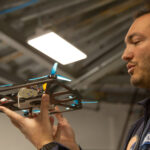
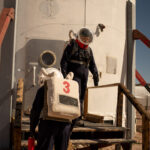
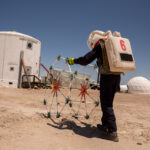
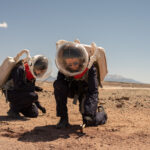
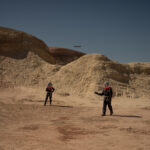
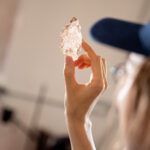
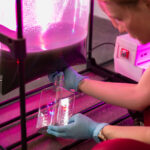
You must be logged in to post a comment.